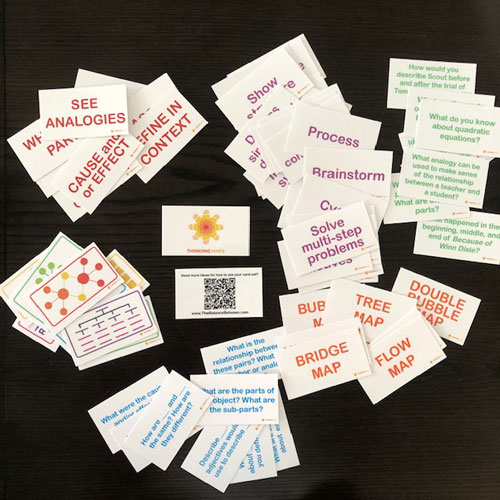Card Sort
 Looking for great ideas on how to use your Thinking Maps® card sort set???
Looking for great ideas on how to use your Thinking Maps® card sort set???
ACTIVITIES to DEVELOP MAP FLUENCY
- Sort the cards in any way that makes sense.
- Remove the Map images. Sort the cards.
- Remove the Map images and names. Sort the cards.
- Sort the cards by Map. Add sticky notes to the end of each category and create a Map example for each category that you would use
- Sort the cards by Cognitive Process/Map. Time yourself. Do it again. Did you get faster? Repeat.
- Sort the cards by Cognitive Process/Map. Come up with an example Guiding Question for each category.
- Sort the cards by Cognitive Process/Map. Come up with an example Command for each category.
- Add a new set of cards with Guiding Questions relevant to __________
PARTNER or GROUP ACTIVITIES
- Lay the cards (all or some of the card categories) out face down and play Concentration/Memory. (Must have 4 related terms to match.)
- Sort out the cards and remove a card from any category with an odd number. Deal out the cards. Play Old Maid with pairs by Cognitive Process category- let the Thinking Maps header card be the “Old Maid”.
- Use the cards to group kids homogeneously (by Cognitive Process/Map) or heterogeneously (by Cognitive Process/Map).
- Select a card to do an exit ticket.
- Select a card to do a warm-up/bell ringer activity.
- Watch a movie, listen to a song, look at a piece of art and select a minimum of 3 cards and Map the topic.
- Select a card and find the “perfect” representation of that kind of thinking in a short story, poem, song, character, etc.
- Choose a class/group problem to solve. (i.e. noise in the lunchroom, voter fraud, etc.) Choose a card and create a Map or Maps using that Cognitive Process to engage that kind of thinking in an effort to help solve the problem.
- Use the header (Map name or image or cognitive process) cards. Each person/group chooses one and:
- Make a circle map about each Map. “What do you know about ___ Map?”
- Sequence them in order. Try:
- most to least comfortable for you,
- most to least important for a particular task or text,
- most to least used by you, students, teacher, ages, etc.
- Describe each Map.
- Choose 2 header cards:
- Create a Double Bubble Map. What do these 2 Maps have in common?
- Create a Bridge Map - What relating factor works?
- Think of as many ways as possible to categorize the Maps:
- Easier/harder to draw
- Easier/harder to use
- More or less effective for a particular task
- Which use circles? Rectangles? Lines?
 Looking for great ideas on how to use your Thinking Maps® card sort set???
Looking for great ideas on how to use your Thinking Maps® card sort set???